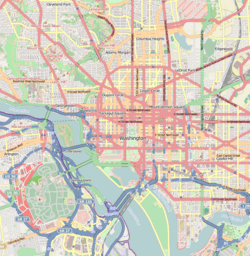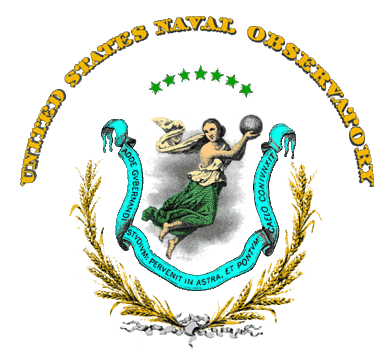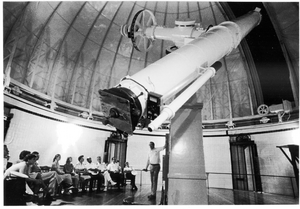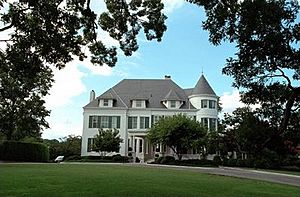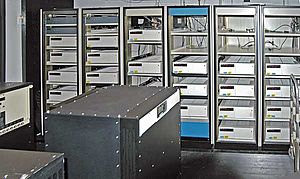United States Naval Observatory facts for kids
Quick facts for kids Naval Support Facility US Naval Observatory |
|
|---|---|
| Part of Naval Support Activity Washington | |
| Northwest Washington, D.C. in the United States | |
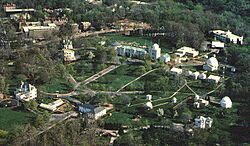
An aerial view of the United States Naval Observatory in 2004
|
|
 |
|
| Coordinates | 38°55′17″N 77°4′1″W / 38.92139°N 77.06694°W |
| Type | Military observatory and official residence of the US Vice President |
| Site information | |
| Owner | Department of Defense |
| Operator | US Navy |
| Controlled by | Naval District Washington |
| Condition | Operational |
| Site history | |
| Built | 1830 (as Depot of Charts and Instruments) |
| In use | 1830–present |
| Garrison information | |
| Current commander |
Captain Mark Burns |
| Garrison | United States Naval Observatory |
The United States Naval Observatory (USNO) is a special place that helps the United States Navy and the United States Department of Defense with important information. It provides data for geopositioning (knowing where things are), navigation (finding your way), and timekeeping (keeping accurate time).
It started in 1830 as the "Depot of Charts and Instruments." This makes it one of the oldest science groups in the United States. Today, it is still a top facility for studying stars and keeping time.
The observatory is in Northwest Washington, D.C.. It is one of the few old observatories still in a city. In 1893, it moved to its current spot to get away from light pollution (too much city light making it hard to see stars).
The USNO has done many important scientific studies. These include measuring the speed of light and finding the moons of Mars. It also helped create the first radio time signals and develop universal time.
Besides its science work, the USNO campus is also home to Number One Observatory Circle. This is the official house for the U.S. Vice President.
Contents
President John Quincy Adams wanted to create a national observatory. In 1825, he signed a bill to make this happen. He even spent many nights watching and charting the stars himself.
The observatory officially began on December 6, 1830. It was first called the "Depot of Charts and Instruments." Its main job was to fix and check navigation tools for the Navy.
Early Days and the First Location
The observatory became a national observatory in 1842. Congress gave $25,000 to buy telescopes and books. Lt. James Melville Gilliss traveled to Europe to find the best equipment.
Its main task was to take care of the Navy's marine chronometers (very accurate clocks). It would check these clocks by watching stars cross the sky. The first observatory opened in 1844 in Foggy Bottom, Washington, D.C.
In 1893, the observatory moved to its current location. This new spot was on "Observatory Hill" in Northwest Washington, D.C. The buildings at this new site were added to the National Register of Historic Places in 2017.
The Time Ball and Accurate Time
The first leader of the observatory was Navy Commander Matthew Fontaine Maury. He had the world's first vulcanized time ball made. This time ball started working in 1845. It was the first in the United States.
The time ball would drop every day at exactly noon. This helped ships and people nearby know the correct time. Later, the observatory's clocks were linked by telegraph. They would ring fire alarms in Washington, D.C., three times a day.
Measuring Earth's Distance to the Sun
One important job for the observatory was to help figure out the Astronomical Unit (AU). This is the average distance between the Sun and the Earth. Scientists used observations of Venus passing in front of the Sun.
Naval observers took many photos during these events in 1874 and 1882. Their work helped to get a much more accurate measurement. They calculated the Earth-Sun distance to be about 92,797,000 miles (149,340,000 km).
Powerful Telescopes and New Locations
The 26-inch (66 cm) refractor telescope was used to discover the Moons of Mars. It was moved to the new Northwest D.C. location in 1893.
In 1934, an even bigger telescope, a 40-inch (102 cm) instrument, was installed. This telescope was designed by George Willis Ritchey. His design is now used for almost all large telescopes, including the Hubble Space Telescope.
Because of light pollution in Washington, D.C., the 40-inch telescope moved. It went to Flagstaff, Arizona, in 1955. This new site became the USNO Flagstaff Station (NOFS). Later, an even larger 61-inch telescope was built there.
The USNO still runs the NOFS observatory in Flagstaff. This facility helps with important sky observations.
Keeping Time for the Nation
By the 1870s, the USNO's daily noon-time signal was sent across the country by telegraph. Railroads used this time to schedule trains. In the early 1900s, the time service began broadcasting by radio.
Today, the U.S. Naval Observatory is still a main source for precise time. It also helps with Earth's orientation and studying stars. It works with other science groups to provide data for navigation and astronomy.
A former director, Gernot M. R. Winkler, started the "Master clock" service. This service provides very accurate time to the GPS satellites. These satellites are run by the United States Space Force.
Departments and Operations
The USNO has different departments that handle its various tasks. One important part is the Naval Observatory Flagstaff Station (NOFS). This station in Flagstaff, Arizona, focuses on observing the sky under dark conditions.
Home of the Vice President
A house on the observatory grounds, at Number One Observatory Circle, has been the official home of the U.S. Vice President since 1974. The Secret Service protects the house.
Before it became the Vice President's home, it was where the observatory's superintendent lived. Later, it was home to the Chief of Naval Operations.
How the Time Service Works
The U.S. Naval Observatory has two "Master Clock" facilities. One is in Washington, D.C., and the other is at Schriever Space Force Base in Colorado.
- The main facility in Washington, D.C., uses 57 high-performance cesium atomic clocks and 24 hydrogen masers.
- The other facility in Colorado has 12 cesium clocks and 3 masers.
These clocks are kept in special rooms where the temperature and humidity are very stable. The "Master Clock" is not just one clock. It is a combined "vote" from many clocks working together. This makes the time incredibly accurate.
The USNO shares its precise time with the public. You can get it through 26 NTP servers on the Internet. You can also call these phone numbers:
- +1 202 762-1401 (Washington, DC)
- +1 202 762-1069 (Washington, DC)
- +1 719 567-6742 (Colorado Springs, CO)
The voice of actor Fred Covington has been announcing the time since 1978. The announcements tell you the local time and also Coordinated Universal Time (UTC). The USNO also provides time to the Global Positioning System (GPS).
See also
 In Spanish: Observatorio Naval de los Estados Unidos para niños
In Spanish: Observatorio Naval de los Estados Unidos para niños
- dark-sky movement
- List of astronomical observatories
- Old Naval Observatory
- USNO Flagstaff Station
- Coordinated Universal Time (UTC)
- time ball
- Time signal
- time service radio stations WWV, WWVH, & WWVB


